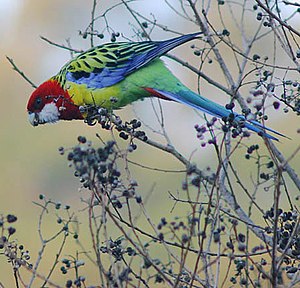Rosella Parakeet
| Rosella Parakeet | ||||||||||||
|---|---|---|---|---|---|---|---|---|---|---|---|---|

Rosella Parakeet ( Platycercus eximius ) |
||||||||||||
| Systematics | ||||||||||||
|
||||||||||||
| Scientific name | ||||||||||||
| Platycercus eximius | ||||||||||||
| ( Shaw , 1792) |
The Rosella Parakeet ( Platycercus eximius ), engl. Eastern Rosella , is a species of parrot belonging to the flat-tailed parakeet genus . The natural range of the Rosella Parakeet is the southeast of Australia and Tasmania. There are three subspecies. The species has also been introduced and established in New Zealand. Rosella Parakeets are very common birds in Australia.
Despite the apparently very conspicuous plumage, Rosella Parakeets are very well camouflaged. In the wild, they are often only noticed when they are blown up in front of humans.
Appearance
The Rosella Parakeet reaches a body length of 30 centimeters and weighs between 90 and 120 grams.
In the male, the head, neck and upper chest are bright red, the cheek spots are sharply delineated from the rest of the head plumage. The underbust is yellow and turns a light green on the stomach. The under tail coverts and the anus region are red. The neck, the front back and the umbrella feathers have wide yellow-green hems. The wing crease as well as the outer middle wing covers and the outer arm covers are blue-violet. The hand wings and the arm wings as well as the hand covers are brownish black. The back, rump, and upper tail-coverts are light green. The individual feathers have a very fine dark border. The beak is grayish horn-colored. The iris is dark brown.
Females are similar to males, but the red of the head and upper chest is a little paler. The red feathers are also a bit smaller. Young birds are similar to adult females, but their plumage is much more dull. Their neck and head are often green. The full color is achieved after about 1½ years.
There are three subspecies of the Rosella Parakeet : diemenensis (eastern Tasmania), eximius (Victoria and southern New South Wales) and elecica (northern New South Wales), the latter being the actual rosella. However, the subspecies are also paired with each other, which happens both in the wild and in breeding.
flight
Rosella parakeets have an undulating flight over short distances. Their landing maneuvers are striking: they fly from one tree to the next, first slide almost down to the ground, then fan out their control springs just before the ground and finally land on the target branch with an upward movement. Rosella Parakeets, on the other hand, which cover longer distances, tend to fly in a straight line and often at considerable heights.
Habitat and behavior
The Rosella Parakeet uses open savannahs or light forests as habitat . Dense forests, on the other hand, are populated by the Pennant Parakeet and the Yellow-bellied Parakeet, two species belonging to the same genus as the Rosella Parakeet. The Rosella Parakeet can also be found in groups of trees that line agriculturally used areas as well as in remnants of tree savannah on farmland. It has also adapted to urban living spaces and uses golf courses as well as urban parks and gardens. Rosella parakeets often visit haylofts, storage sheds and chicken farms to pick up the grains scattered there.
Rosella parakeets mainly eat grass seeds and the seeds of herbaceous plants. They mainly take their food on the ground. The food spectrum also includes seeds and fruits from bushes and trees as well as berries, nuts, buds, leaves, stems, flowers and nectar. Eucalyptus and acacia trees are of great importance to them. They also like to eat fruit, especially apples and pears, and can cause considerable damage to orchards. Animal food is provided by insects and their larvae.
Rosella Parakeets live in groups or flocks outside of the mating season. Rosella parakeets are cave breeders that usually nest in the period August to February. At the beginning of the breeding season, the calls of the males can be heard more frequently as they begin to claim territories and defend them against rivals. Rosella Parakeets are very fertile and can raise more than two broods in one breeding season. In a pair of Rosella Parakeets kept in human care, there were already three annual breeds, in which a total of 19 young birds were raised. The clutch comprises four to nine eggs. The incubation period is 19 days. It only breeds the female.
Sound recordings of rosella parakeets:
Life in captivity
This bird is unsuitable for keeping in cages. It only unfolds its full beauty when it can fly in an aviary. Wild-colored Rosella Parakeets are only kept very rarely in Australia. There one concentrates almost exclusively on the breeding of mutation forms. Outside of Australia, the subspecies are rarely considered in breeding, so that there are hardly any single subspecies aviary birds.
In aviaries they are lively birds that can become very tame. They can only be kept in pairs as they are very aggressive, similar to other large species of flat-tailed parakeets. Keepers even recommend not keeping any other species of flattail near the aviary.
supporting documents
Individual evidence
- ^ Forshaw, p. 460
- ^ Forshaw, p. 435
- ^ Forshaw, p. 461
- ^ Forshaw, p. 458
- ^ Forshaw, p. 461
- ^ Forshaw, p. 464
- ^ Forshaw, p. 464
literature
- Joseph M. Forshaw : Australian Parrots. 1st German-language edition. Volume 2, Arndt-Verlag, Bretten 2003, ISBN 3-9808245-2-7 .
Web links
- Platycercus eximius in the endangered Red List species the IUCN 2008. Posted by: BirdLife International, 2008. Accessed January 31 of 2009.
- Videos, photos and sound recordings of Platycercus eximius in the Internet Bird Collection
- Information about husbandry, care, health ...

